LL-9025 Outdoor Weathering: Basic Exposure Procedures
Technical Bulletins
Posted 2023
Last Updated 2025
LL-9025
Weathering and corrosion test data are necessary for the selection of new materials and the improvement of existing materials. The main weathering forces that may cause material degradation are sunlight, high temperature, and moisture. Outdoor exposures are used to test the weathering durability of materials. The forces that cause product deterioration vary greatly from location to location throughout the world. Florida and Arizona have become international benchmarks for natural weathering.
Why Florida?
Florida has high-intensity sunlight, high year-round temperatures, high annual rainfall, and high humidity. When combined, these factors create the harsh climate that makes Florida the ideal location for testing exterior durability. Because they provide something of a “worst case,” Florida weather conditions typically produce faster deterioration than the weather in more northern locations. Although Florida has high levels of these "forces of weathering," it typically does not experience extreme conditions, meaning that testing outdoors is accelerated, yet realistic. This is the primary motivation for testing outdoors in Florida.
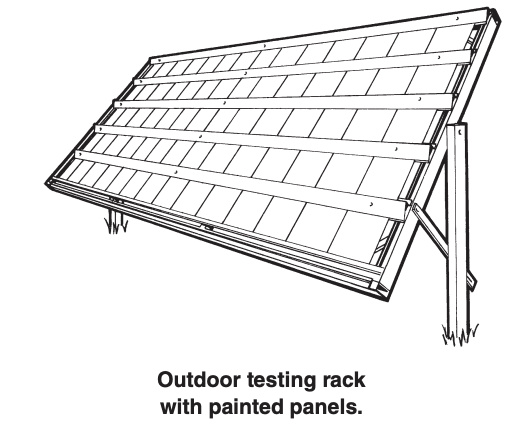
Why Arizona?
Arizona has a hot, dry, high-UV radiation environment, particularly suited for the weathering of materials susceptible to these harsh conditions. Arizona exposure testing is widely used because the annual total solar and total UV radiation exceeds Florida by about 20%. This is attributed to Arizona's significantly higher percentage of sunlight in the direct beam portion of the solar spectrum. In addition, maximum air temperatures in Arizona are commonly 8 °C (15 °F) hotter than those in Florida, and Black Panel temperatures may be 11 °C (20 °F) hotter. Arizona also has extreme temperature fluctuations that may subject materials to changes in dimension due to expansion and contraction. The seasonal variations and temperature fluctuations are terrific for material durability testing. The high solar energy in the day and the cooler temperatures in the winter evenings can result in fast failures that would be seen in the more mild enivornment of neighboring states like California, New Mexico, and Wyoming. Arizona's unique climate is especially useful for testing certain types of materials. Particularly affected are: color and gloss of coatings, color stability, heat aging and physical properties of plastics, lightfastness and tensile strength of textiles.
Exposure Methodology
Various mounting and exposure techniques are available for conducting natural outdoor exposure tests. Each has advantages and limitations, depending on the material or product’s end use. Care must be taken to pick the proper exposure methodology to ensure that the test results are as useful as possible. This paper will outline some of the more significant issues including:
- Mounting Techniques
- Effect of Exposure Angle
- Effect of Mounting on Temperature & Moisture
- Seasonal Variations in Exposure Conditions
Choosing an Exposure Angle and Mounting Method
Not all exposures are equal. The specimen mounting technique and the exposure angle have a significant effect on each of the following critical test parameters:
- Solar Energy Dosage
- Specimen Temperatures
- Moisture and Time of Wetness
Exposure Angle
To maximize sunlight dosage, test specimens are normally mounted facing toward the Equator.
Any object exposed outdoors will receive more solar energy when the sunlight strikes it directly2 than when the light comes from an angle. Therefore, the angle at which a test specimen is exposed affects the amount of solar radiation that it will receive. In Florida and Arizona, the sun reaches a very high zenith (height above the horizon) during the summer. The sun is almost directly overhead in Florida in mid-summer. Therefore, in the summer specimens exposed at 5° from the horizontal will receive more total solar energy than those exposed at 45°. In the winter, when the sun doesn’t reach as high in the sky, specimens exposed at 45° receive more total sunlight energy.
As a result, the angle of exposure, sometimes called "tilt angle", has a significant impact on a specimen's response to its environment. Tilt angle determines the specimen's received dosage of solar radiation and rate of heat build-up and cool down. Tilt angle also influences the amount of time that the specimen is wet because of dew formation, rainfall, or drying winds.
As a general rule, the exposure angle used should be representative of the material’s expected service environment. Exposure at the correct angle ensures that the test will be realistic and increases confidence in the results. Following are the most commonly used exposure angles. All angles are measured from the horizontal.
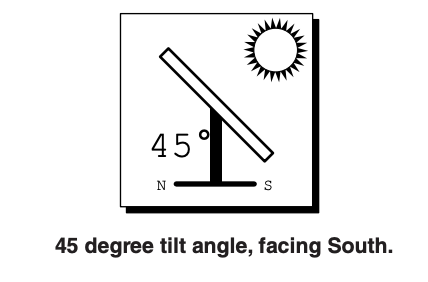
45° South. This is the most common outdoor exposure angle and is the angle of choice for many industries. It is widely used for materials that do not have a specific end-use angle.
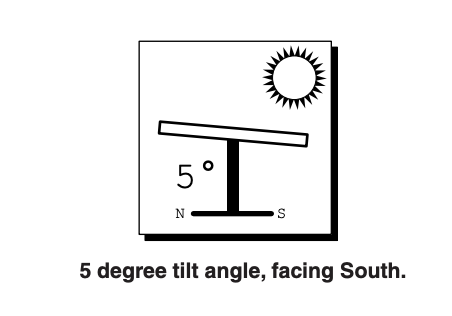
5° South. This is utilized for automotive products and other materials which are normally used at, or near, a horizontal angle in service. The slight tilt allows water to drain off the test specimens. Compared to 45°, this tilt angle is more harsh because it receives more annual solar radiation, especially during the summer months when the effects are enhanced by higher temperatures. This 5° tilt angle also collects more dew, and retains moisture longer than the 45° tilt angle.
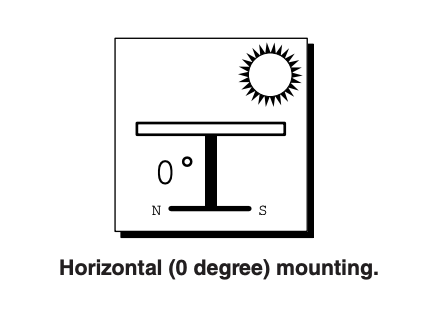
0° (Horizontal). Horizontal exposures are rarely used for flat specimens or panels, because the slight tilt of 5° is preferred to allow for water run-off. However, this angle is useful for many threedimensional parts and specimens. It is also used for applications, such as roofing, where water ponding is required.
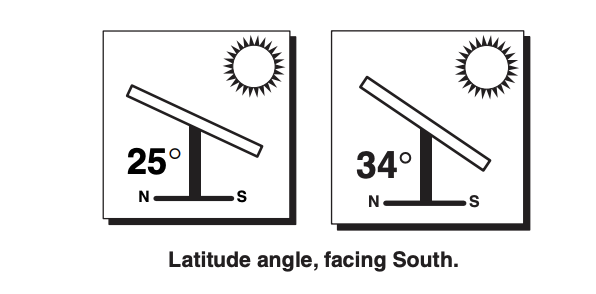
Latitude Angle. 25° North is the latitude of our test site in Florida. 34° North is the latitude of our test site in Arizona. Specimens mounted at 25° or 34° facing South will generally receive the most solar radiation of any fixed angle at those respective locations. This parameter is known as Latitude Angle and is used in exposures intended to maximize radiant energy. The “angle of latitude” is also widely used to compare solar devices such as power cells and solar heaters.
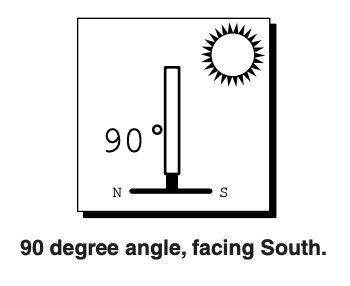
90° South. This fixed, vertical angle is most commonly used for residential coatings. A vertical tilt angle results in greatly reduced solar radiant exposure, lower exposure temperatures, and less wet time. The panels are typically exposed in offset racks, so that water cannot drip from the upper panels onto the lower panels.
Although most tests on residential coatings face south, Florida exposures for mildew resistance are frequently mounted facing North.
Variable Angle. Variable Angle exposure is seasonally adjusted from one tilt angle to another. The angle change is designed to maximize solar radiation by aligning the specimens at normal incidence (right angles) to the sun at each time of the year. A Variable Angle exposure can increase total radiant exposure by as much as 10%, compared to a fixed exposure. The Variable Angle schedule is as follows:
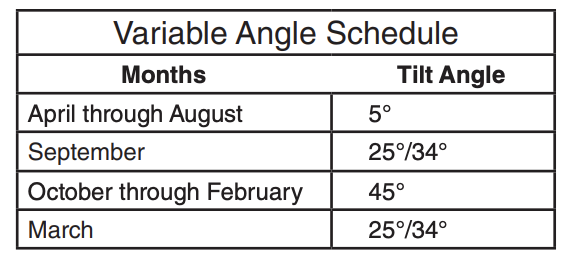
Common Specimen Mounting Methods
Natural weathering exposures are typically conducted in standard frames or racks designed to securely hold test specimens in place without causing damage and without interfering with the progress of the test. Test fixtures used in natural weathering may be made from either wood, aluminum, or stainless steel. Most racks used in the industry are made from aluminum and are easily adjusted to any angle of exposure.
The basic exposure rack is typically 5 feet by 12 feet (1.5 by 3.6 meters), and consists of a support framework and specimen mounting hardware on top. There are two basic mounting systems: one for flat, rigid, self-supporting panels and another for three-dimensional products, parts or components. Flexible materials like textiles often require additional support systems.
Direct Exposures. The most widely used mounting method for most materials is Direct Exposure. Test specimens are mounted on an exposure rack so that the front surface of the test specimen faces the sun and has no cover. Direct Exposure specimens are affected by all elements of the atmosphere.
The Direct Exposure rack is highly adaptable and can hold a variety of specimens. The most common test specimen is a flat, self supporting panel. The panel is usually made of aluminum, steel, wood or plastic. The "standard" specimen is a 12 inch (30 cm) long panel, although the racks can quite easily accommodate panels as small as 6 inches (15 cm), and as large as 24 inches (60 cm). Panels are normally fastened into place by an aluminum clamp which covers the top 2.5 inches (6.4 cm). This clamp also acts as a mask.
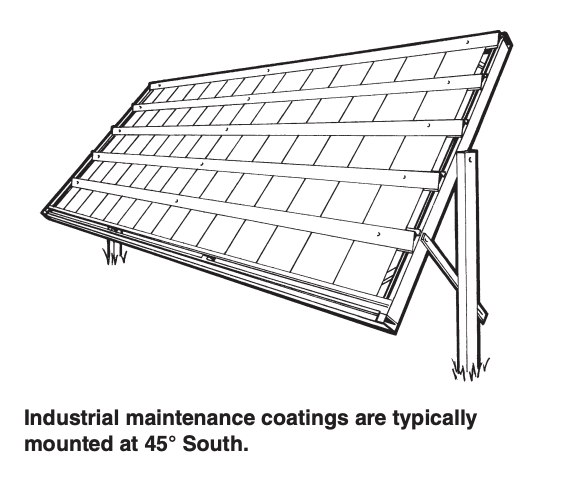
Open Backed Mounting. Specimens on the Direct Exposure frame may be exposed either with or without backing. Open backed mounting is the most commonly used method for rigid panels, glass, free-film, plastic and metal sign material, coil coatings, and plastic lenses such as taillight assemblies, etc. In these exposures, test specimens rest on an open framework, usually facing south, and are open to the elements on both the top (face) and bottom (rear). When specimens need to be supported but do not require the extra heat load, a mesh style expanded metal backing is used.
Backed Mounting. Non-rigid specimens, threedimensional parts and specimens requiring higher temperatures are often mounted onto a plywood backing. This is commonly called backed or plywood-backed mounting. This solid backing will typically result in greater total wet time and in higher temperature exposures than an open back mounting.
Materials typically exposed with backed mounting are roofing membranes, vinyl siding, elastomers, automotive coatings, industrial coatings and coil coatings.
Direct exposure methods are covered by standard procedures including : ASTM G7, ASTM D1435 and SAE J1976
Black Box Exposures. The purpose of a Black Box Exposure is to imitate the conditions found on the trunk and hood of an automobile. The typical exposure frame is an aluminum box 5 feet × 12 feet × 9 inches deep (1.5 × 3.6 × 0.2 m). The test panels form the top surface of the box when they are in place. The top surface must always be completely enclosed, so blank or “dummy” panels are used to fill in any empty spaces.
The Black Box may be used at any angle, but it is normally positioned at a 5° tilt (from the horizontal), which represents the horizontal surfaces on the car.
Black Box Exposures typically result in higher exposure temperatures and a greater total wet time than open backed exposures.
The Black Box exposure method is covered by ASTM D4141.
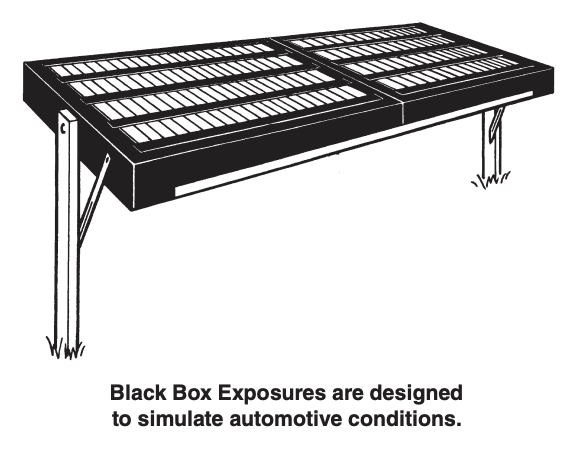
Mildew Enhanced Exposures. Tests for mildew growth resistance are performed using a standard Direct Exposure rack, positioned vertically (90° from the horizontal) in an area of the test field that is known to be conducive to fungal growth. Sometimes the specimens are oriented to face north to reduce sunlight exposure. Sometimes the rack is positioned under a natural tree canopy where temperature and humidity are ideal for growth. Sunlight, which might normally act as a mildewcide, is reduced by the shaded exposure. The natural vegetation acts as a source of mildew spores and decreases the time needed for the growth to begin.
Salt Accelerated Outdoor Exposures. This exposure method uses a combination of direct exposure (at 5° or 45°), and a twice-weekly spray with a 5% salt solution. The panels are sprayed until the surface is completely soaked. The spraying is done when the panels are dry so that maximum absorption occurs. This type of Salt Spray Exposure is known as a “Scab Corrosion” test and has been proven to be a reliable method for predicting long-term cosmetic corrosion of coated metals.
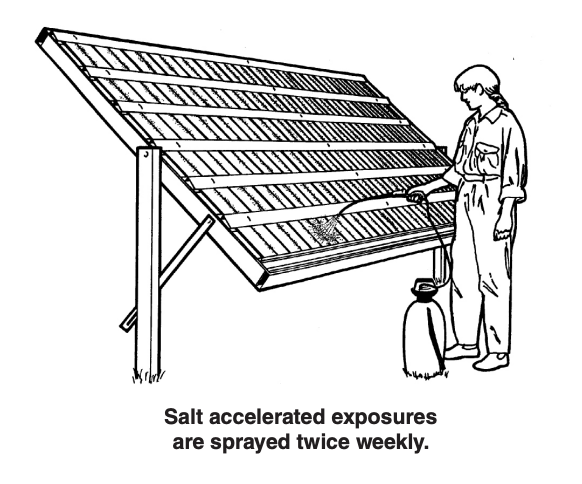
Under Glass Exposures. Glass of any type filters the shorter, more damaging wavelengths of the solar spectrum. The figure below shows the UV region of direct summer sunlight, compared to sunlight filtered through ordinary window glass (single strength, untinted, 0.125 inch (3 mm) thick). As the figure shows, ordinary glass is essentially transparent to light above about 370 nm. However, the filtering effect becomes more pronounced with decreasing wavelength. The most damaging wavelengths shorter than about 310 nm are completely filtered out.
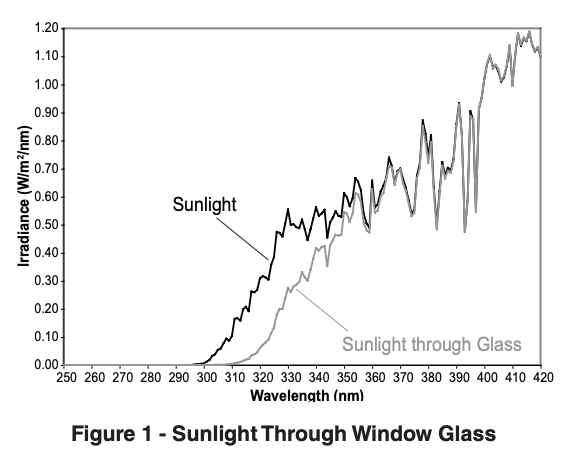
Under Glass Exposures are used to test materials intended for interior use. Test specimens are exposed inside a ventilated framework 3 inches (7.5 mm) behind a glass cover. The glass is typically single or double strength window glass. The glass filters out the most damaging portion of sunlight—the short wavelength UV. The cover also protects the specimen from direct rainfall and most condensation. However, the material is subject to normal humidity variations. A typical frame contains 6 exposure sections with an exposure area of about 24 inches x 42 inches (61 cm x 107 cm) each.
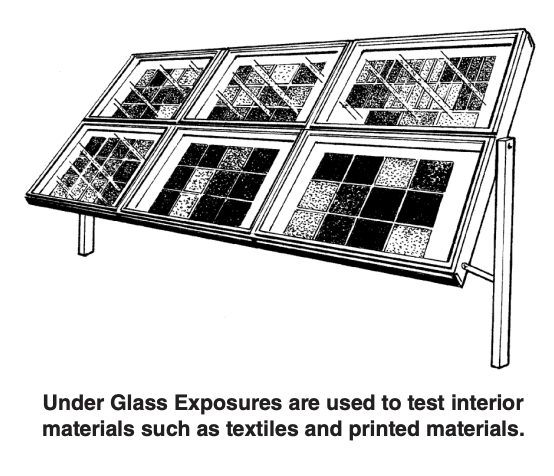
The glass cover must be cleaned periodically to prevent dirt and mildew build-up that might affect the solar transmittance of the glass. Most Under Glass Exposures are conducted with the specimens mounted on a wood backing. The glass frames are typically positioned at a 45° angle in Florida, although sometimes 5° is used to increase the amount of solar radiation received by the specimens.
Under Glass Black Box Exposures. As the name suggests, this exposure is a combination of the Black Box and the Under Glass frames. It is used to test interior automotive materials. The glass cover protects the specimen from direct rainfall, and modifies the solar energy received by the specimens. The Black Box causes higher specimen temperatures than conventional under glass testing. On a clear summer day in Florida or Arizona, the Under Glass Black Box can reach temperatures in excess of 100 °C (212 °F). This frame is normally exposed at a 5° angle, but is also sometimes operated on a Variable Angle schedule in order to maximize solar radiant exposure.
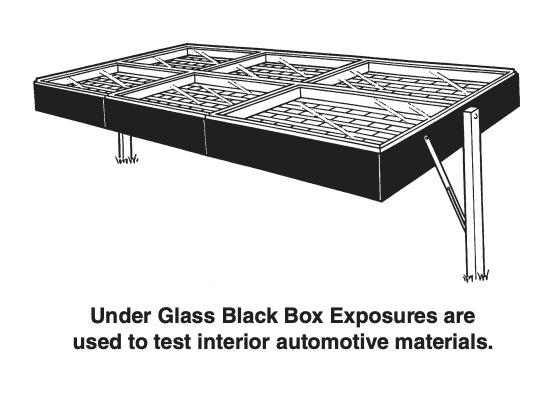
Under Glass Sealed Exposures. This exposure is used to test large automotive interior components. Some AIM Boxes are designed as tracking devices, and follow the sun to maximize solar exposure. They are similar to an Under Glass Black Box, except that the depth of the box has been increased to accommodate larger sample sizes. The test specimen is mounted so that the region of interest is approximately 3 inches (7.5 cm) below the glass cover.
Under Glass Sealed Exposures are covered in GM 9538P.
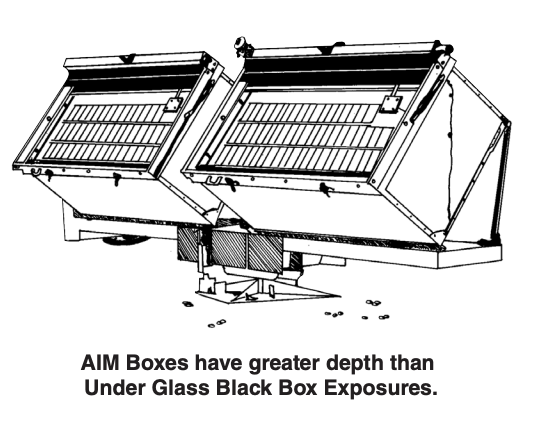
Effect of Mounting Type on Temperature
Heat aging can, by itself, cause material degradation. In addition, the destructive effects of sunlight exposure can be accelerated when temperature is increased. Although temperature does not affect primary photochemical reactions, it does affect secondary reactions involving the byproducts of the primary photon/electron collision. The figure below demonstrates this effect in polyethylene exposed to UV in a lab at various temperatures.
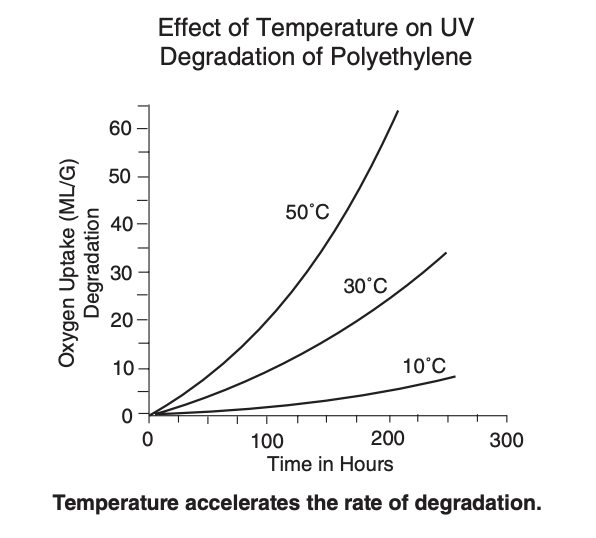
Due to its high year-round temperatures, extreme temperature fluctuations, and high-intensity sunlight, Arizona is an ideal location for outdoor durability tests. Maximum air temperatures are commonly 8 °C (15 °F) hotter than in Miami, Florida. High air temperatures are a major factor in both backed and unbacked Arizona exposure tests.
In addition, Black Panel temperatures in Arizona can get up to 11 °C (20 °F) hotter than those in Florida. The following table gives comparative temperature differences.
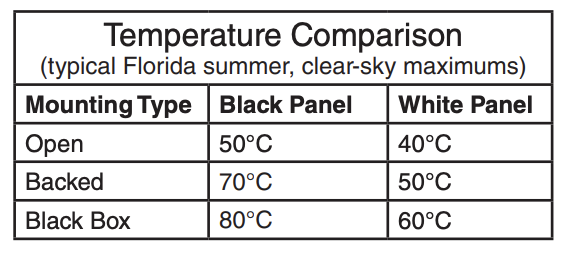
The manner in which a test specimen is backed can be used to increase the specimen’s exposure temperature. The plywood material that is used in backed exposures insulates the test specimen. Backed exposures may be as much as 11 °C (20 °F) hotter than equivalent, unbacked exposure.
Black Box Exposures get even hotter yet. During the day, the Black Box raises the temperature of the exposed panels by acting as a large heat sink. The box be heated by the sun to as much as 30°C above the temperature of an open backed Direct Exposure.
Effect of Mounting Type on Moisture
Both Black Box and plywood backed specimens (under direct exposure) will typically experience much more wet time than unbacked specimens. This is because most outdoor moisture comes from dew formation. To understand the mechanism, we have to understand what causes dew formation on test specimens.
Dew only forms on specimens that are cooler than the surrounding air. This can occur at different temperatures, depending on the relative humidity. The higher the relative humidity (as in Florida), the smaller the temperature difference needed for dew formation.
Each night, test specimens are subject to radiative cooling when they are exposed to the cold night sky. The specimens lose heat very rapidly and the top surface will become cooler than the ambient air temperature. At the same time, there is convective heat exchange with the air at the bottom of the specimen. Specimens eventually reach a balance between the conflicting forces of radiative cooling on the top side and convection heating or cooling at the bottom side. Insulated specimens lose heat faster than they gain it. Open backed specimens are more greatly influenced by the ambient air temperature. Consequently, insulated exposures get wet faster and have longer wet times than unbacked exposures.
Seasonal Variability in Exposure Conditions
There are important seasonal differences in exposure conditions. These differences are particularly important for products that have a short service life. The most important differences are:
- Quantity and Quality of Sunlight
- Amount of Humidity and Time of Wetness (TOW)
- Average and Maximum Specimen Temperature
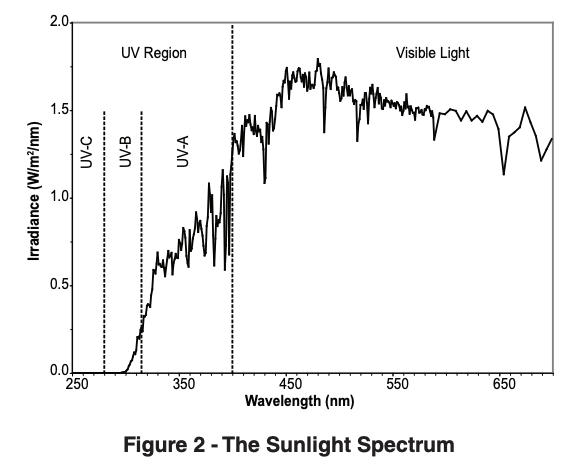
Seasonal Changes in Sunlight. Because the sun is lower in the sky during the winter months, sunlight strikes the exposed specimens at an oblique angle. This has significance in specimen mounting methodology (previously discussed above). During the winter months, the sun is also filtered through a greater air mass. This creates seasonal differences in the intensity and spectral distribution of the light. These effects are affected by the amount of cloud cover, atmospheric moisture, and temperature.
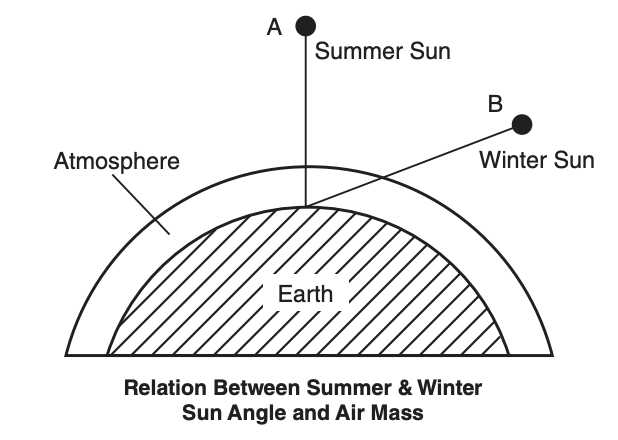
Seasonal Variations in Temperature. The temperature of an exposed specimen is determined by two factors: (1) the ambient air temperature and (2) the solar energy to which it is exposed. Ambient air temperature is generally higher in the summer and, combined with radiant heating from the sun on clear a day, can create black panel temperatures as great as 80 ˚C (176 ˚F).
Seasonal Variations in Moisture. In the summer in Florida, the combination of heavy rainfall and dew (condensation) can cause test specimens to have liquid water on their surface for over 50% of the time.
Miami’s dry season runs from December through April. During this time, rainfall may drop to levels which can cause temporary drought conditions. However, even during these dry periods, Florida’s high relative humidity assures significant time of wetness from dew formation. Typical winter-time time of wetness is more than 60%.
The Arizona climate is low in rainfall and ambient humidity. Moisture is not normally of concern. Water can be added artificially to test specimens in order to accentuate the overall weathering effect.
Short-Term Tests. Seasonal differences tend to average out during longer-term exposure tests (more than two years). However, these differences may have a significant effect on test results for less durable products and materials designed to have shorter service lives, like bumper stickers, decals, some printing inks and some textiles. The shorter the exposure time, the more significant the effects of seasonal variation may be. Seasonal differences can affect the time to failure, the mode of failure, and even the ranking of a specimen, relative to an array of similar materials.
The ideal way to test materials which have a short service life is to expose a replicate test array at each season of the year. If there is an urgent need for information, the client should test immediately, regardless of the season, but should keep in mind that there is potential for seasonal differences. When time is not the main issue, but economics are an overriding factor, the client should test during the summer, which is normally the season of greatest severity.
Accelerated Outdoor Testing
It is possible to accelerate a natural exposure by using an exposure technique that subjects the material to conditions that are more severe than LL-9025.3 © 2025 Q-Lab Corporation. All Rights Reserved. See Q-Lab.com/Trademarks for trademark information. the normal service environment. For example, a plywood backing will cause a test panel to experience higher temperatures and more hours of wetness than an unbacked panel. In a similar fashion, a specimen mounted at variable angle will be exposed to higher radiant energy than a specimen mounted on a fixed rack. Depending on the normal end-use application, these exposures could be considered accelerated exposures.
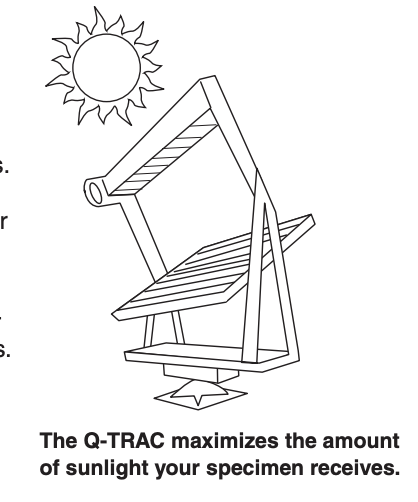
Solar Concentrator. Another accelerated outdoor test, known as a solar concentrator, is commonly performed in Arizona. Our Q-TRAC® Natural Sunlight Concentrator is a device that automatically follows the sun from morning until night. It uses a series of 10 mirrors to reflect full spectrum natural sunlight and concentrate it onto test specimens. This follow-the-sun solar concentrating system maximizes the amount of sunlight exposure that your test specimen receives. Solar Concentrator exposures are covered in ASTM G90. For a complete explanation of QTRAC testing, refer to Q-Lab Corporation Technical Bulletin LL-9031.
Conclusion
Weatherability data is necessary for the selection of new materials and the improvement of existing materials. The forces that cause product degradation vary greatly from place to place throughout the world.
Both Florida and Arizona have become accepted internationally as benchmark locations for testing. Each has a climate that allows for rapid testing, yet under different conditions. Florida is characterized by high intensity sunlight, high rainfall, high temperatures and high humidity. Arizona is characterized by extremely high sunlight energy levels and very high temperatures
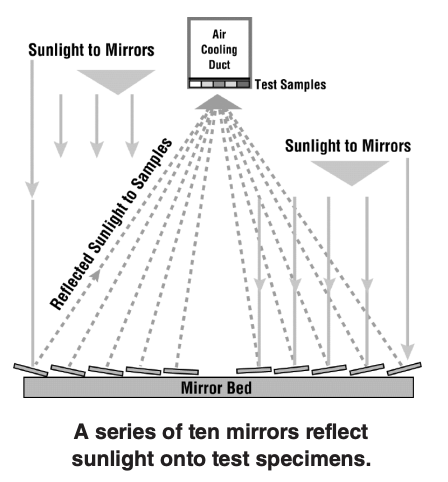
Various mounting and exposure techniques are available for conducting natural exposure tests in Florida. Each has advantages and limitations, depending on the material or product’s end use application. Care must be taken to pick the proper exposure methodology to ensure that the test results are as useful as possible.